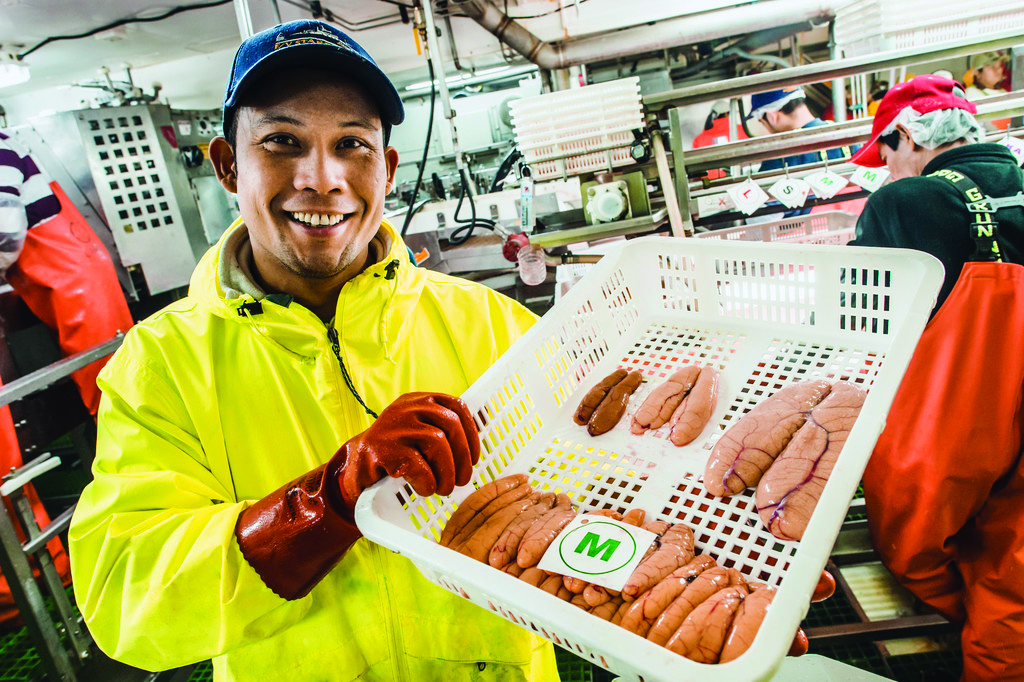The strength of the Alaska seafood portfolio lies in our wide assortment of species and product forms. In 2018, Alaska produced more than 2.4 million metric tons of seafood, more than all other U.S. states combined. We proudly offer some of the most expensive seafood in the world and also boast a high volume of good value products. At the Alaska Seafood Marketing Institute, the official seafood marketing arm for the state of Alaska, we often use the message, “We have something for everyone.”
While nature provides us with our diversity of seafood species, the ASMI international program works to create diverse markets. Depending on the odd-even cycle of the pink salmon returns, roughly half or more of the Alaska seafood annual harvest is exported. In 2018, export value reached $3.3 billion and Alaska’s seafood is currently exported to more than 100 countries. However, China, Japan and the EU continue to dominate as the major markets for Alaska seafood. Certain products, such as herring roe, or kazunoko, suffer from declining monopolistic markets. Compounding this issue, the past year has brought unprecedented uncertainty in international trade, with tariffs implemented or threatened in major markets and uncertainty in Europe continuing as Brexit remains in limbo. In order to support and increase diversity in global markets, ASMI recently made several big international moves.
In the spring of 2019, the USDA Foreign Agriculture Service awarded ASMI $5.5 million in supplemental grant funding through the Agricultural Trade Promotion program, a three-year program designed to help ease the adverse effects of tariff and non-tariff barriers on U.S. agricultural exporters.
Using these funds, ASMI officially opened an office in Thailand in May 2019, beginning a year-round marketing program in Southeast Asia. Prior to this boost in funding, ASMI participated in several projects, such as outbound missions and trade shows targeting the region. The new dedicated program will focus efforts in Thailand, Vietnam, Indonesia, Singapore, Malaysia and the Philippines, with an initial emphasis on building trade relationships, and providing technical support and education across the foodservice, retail and reprocessing sectors. Southeast Asia has a population of roughly 650 million and some of the hottest tourist destinations in the world. Singapore and Thailand both receive millions of visitors each year, especially from China and Japan. The popularity of Japanese cuisine provides a gateway for products like kazunoko and pollock roe (mentaiko and tarako) to enter the market. The region is also known for product innovation across many sectors. ASMI will undertake projects to look for new markets and uses for underutilized species or products, such as cod heads or skate wings, both popular in Korea but with few alternative markets.
In July 2019, ASMI officially expanded its Brazil program to become the ASMI South America program, now encompassing Brazil, Colombia, Uruguay, Argentina and Peru. ASMI began exploring the Brazil market with a study in 2010. The country has long been a market for Alaska cod, but very little of it entered the market directly. Instead, much of the bacalhau (salt cod) that is popular in Brazil headed first to Portugal or Norway for salting before entering the Brazilian market. With a strong traditional preference for Alaska cod, ASMI looked to increase direct exports to this country and capitalize on the growing market. ASMI led two industry missions to Brazil and began a trade and foodservice focused marketing program. Since 2010, direct exports of Alaska seafood to Brazil have grown from 56 metric tons to nearly 5,600 metric tons.
The broader South America market offers interesting opportunities for the Alaska seafood industry. As processors seek alternative markets from the dominant China reprocessing sector, ASMI is planning an exploratory mission taking industry members to Peru, where more than 200 processing facilities already exist, many of which seek more products in order to run at higher capacity. ASMI already has an experienced team in place in Sao Paulo and is poised to capitalize on opportunities in other South American countries.
In a different corner of the world, Eastern Europeans enjoy Alaska salmon roe as caviar on blinis, with butter on toast or right off the spoon. In the coming years, ASMI will use its supplemental funding to bolster work in Eastern Europe to ensure that Alaska salmon caviar is seen as a premium product and to use the popularity of products like salmon roe to build demand for other items available in the market, such as Alaska pollock, pollock surimi, pollock roe and pink and keta salmon.
Although trade conditions continue to challenge the Alaska seafood industry, strong demand and potential exists across the globe. As the productive Alaska waters and hardworking Alaska fishermen supply the world with top-quality seafood, we look forward to sharing the journey.







